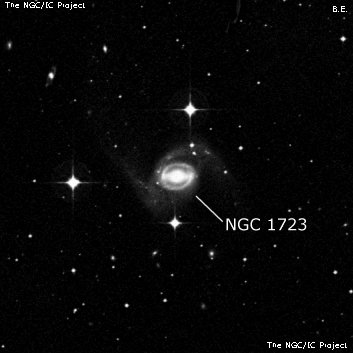
Wilhelm Tempel discovered NGC 1723 = T V-3 on 12 Jan 1882 with an 11" refractor at the Arcetri Observatory and reported "Class III. Situated between two stars 9-10m, which form a triangle with a third." Tempel's micrometric position is very accurate.
E.E. Barnard independently found NGC 1723 on 10 Nov 1885 with the 6-inch refractor at Vanderbilt University, along with the trio NGC 1723, 1725 and 1728 to the south. His position in Sidereal Messenger, vol. 5 (page 25) was 30 seconds of RA too far east. Swift notified Barnard that this "nebula" was discovered earlier by Tempel.
400/500mm - 17.5" (12/3/88): brightest in a group with a trio NGC 1721, NGC 1725 and NGC 1728 about 8' S. Fairly faint, fairly small, slightly elongated, small bright core. Sandwiched between a mag 10 star 2.0' NNW and a mag 11 star 1.3' S. An additional mag 10 star lies 2.9' due east.
600/800mm - 24" (12/28/13): fairly bright, moderately large, well concentrated with a bright elongated core or bar oriented E-W that increases to a small, rounder nucleus. The halo is much fainter and elongated 2:1 NW-SE, ~1.8'x0.9'. The galaxy is bracketed by mag 10 stars 2' N and 2.9' E, with a mag 11 star 1.4' S. The triplet NGC 1721, 1725 and 1728 lies 9' S.
Notes by Steve Gottlieb